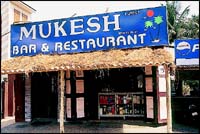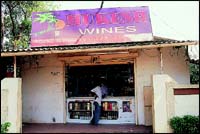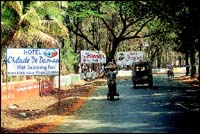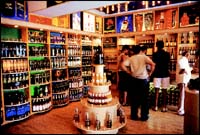


|
|
|
IT�S easy to see why people confuse Daman with Goa. The tiny Indo-Portuguese union territory is tucked on the coast between Maharashtra and Gujarat and is just ten kilometres north of the Bombay-Ahmedabad Highway from Vapi. It has much of the Mediterranean charms of Goa, but fortunately, not its bustling tourism. Tavernas and restaurants, administrative buildings and churches, a harbour with a lighthouse and a fort, a beach and watersports, a palace and a monastery. The residents are more Gujarati than Portuguese, but seeing as how the European colonisers only left Daman in 1961, cultural traces of the Portuguese do remain. And in some taverna or along the stone ramparts of the fort looking onto the port with its armada of fishing boats, it is possible that you might hear old-timers talking and singing of times gone by in fluent Portuguese.
You see them everywhere, carloads and busloads of men coming across the border, sneering at the armed constabulary manning the checkposts, and heading for pubs, restaurants, tavernas, every little place that offers a drink. Unlike Gujarat, which has forever frowned upon the consumption of alcohol, Daman has Portugal�s easy and happy acceptance of liquor. More exciting for drinkers and even teetotalers who might want to take something back, is the fact that Daman has no excise duties. You can drink to your heart�s content, and your thirst will not cost you much. Alternately, you may visit one of the many liquor shops and pick up premium scotch, rum, vodka and gin, or Indian-made foreign liquors, at bargain prices.
Now Chariny has very little to do in the shop except sit at the counter and take the customers� money on their way out. Residents, tourists visiting Daman, stroll in and browse around Liquor World like they might do at a bookshop. It is a large and colourful store, the bottles of alcohol and the cans and pints of beer, are attractively displayed. Make your selection and pay on your way out. Excitingly, the liquor is dirt cheap. �But, beware,� warns Chariny. �You must have a permit and you can carry only two bottles of liquor. Also, you cannot take anything out, because you are passing through Gujarat, and Gujarat is a dry state.� Interestingly, the government of Gujarat also has a liquor shop in Daman from which residents are encouraged to buy their excise-free stock.
|

Home Page
About the mag
Subscribe
Advertise
Contact Us

 Daman For Daru!
Daman For Daru!
 The harbour is picturesque, especially at night, when the great beam of the Daman lighthouse searches the sea. It used to be an important link on the sea route between Goa to the south and Diu to the north, both Portuguese colonies until 1961, and a port for ships sailing to Africa. Portuguese galleons and Arab dhows once navigated its waters, but today, mostly fishing boats come into dock. The union territory is bifurcated by the Damanganga, a river that separates Daman into two, Moti Daman and Nani Daman. The administrative buildings and the old churches come in Moti Daman, which is the large area, while Nani Daman, the smaller part, has the tavernas and restaurants. And it is to these that every evening most people from prohibition-slaked areas of Gujarat nearby rush.
The harbour is picturesque, especially at night, when the great beam of the Daman lighthouse searches the sea. It used to be an important link on the sea route between Goa to the south and Diu to the north, both Portuguese colonies until 1961, and a port for ships sailing to Africa. Portuguese galleons and Arab dhows once navigated its waters, but today, mostly fishing boats come into dock. The union territory is bifurcated by the Damanganga, a river that separates Daman into two, Moti Daman and Nani Daman. The administrative buildings and the old churches come in Moti Daman, which is the large area, while Nani Daman, the smaller part, has the tavernas and restaurants. And it is to these that every evening most people from prohibition-slaked areas of Gujarat nearby rush. The biggest dealer for alcohol in Daman is Liquor World. The shop is owned by Tazdin Chariny and it was started in 1973 with whatever stock was available from liquor company distributors in Daman. Then, three years ago, Chariny renovated the place, making it look like a supermarket for liquor. Or like a Duty Free shop in some European airport. It made sense, because the spirits world was opening up, imported liquors were coming in and people�s drinking habits were undergoing an education and change. Chariny kept up with the times. A luxury product like a scotch or single malt could not be discreetly kept beneath the counter and hope to be sold. It had to be proudly displayed. That�s what he did at Liquor World.
The biggest dealer for alcohol in Daman is Liquor World. The shop is owned by Tazdin Chariny and it was started in 1973 with whatever stock was available from liquor company distributors in Daman. Then, three years ago, Chariny renovated the place, making it look like a supermarket for liquor. Or like a Duty Free shop in some European airport. It made sense, because the spirits world was opening up, imported liquors were coming in and people�s drinking habits were undergoing an education and change. Chariny kept up with the times. A luxury product like a scotch or single malt could not be discreetly kept beneath the counter and hope to be sold. It had to be proudly displayed. That�s what he did at Liquor World. It is called Omnibus Industrial Development Corporation.
Moti Daman is also worth a look if you are visiting Daman. The restaurants, cafes and hotels are located in an area called the Damanganga Tourist Complex. But go beyond the imposing gateways of the St. Jerome Fort there carved with their old-fashioned coat of arms, to the Governor�s Palace with its spectacular flight of stairs and impressive ornate chandeliers, to the Cathedral of Bom Jesu, consecrated in 1603, and the Church of Our Lady. The old Dominican Monastery, unfortunately, is in a state of ruins. But the lighthouse on the north-west end of the fort can be explored and offers one of the finest views of the old union territory. The places to stay at in Daman are the Cidade de Daman which faces the Devka beach (tel: 0260-2250590) or the Hotel Miramar on the beach (tel: 0260-2250671).
It is called Omnibus Industrial Development Corporation.
Moti Daman is also worth a look if you are visiting Daman. The restaurants, cafes and hotels are located in an area called the Damanganga Tourist Complex. But go beyond the imposing gateways of the St. Jerome Fort there carved with their old-fashioned coat of arms, to the Governor�s Palace with its spectacular flight of stairs and impressive ornate chandeliers, to the Cathedral of Bom Jesu, consecrated in 1603, and the Church of Our Lady. The old Dominican Monastery, unfortunately, is in a state of ruins. But the lighthouse on the north-west end of the fort can be explored and offers one of the finest views of the old union territory. The places to stay at in Daman are the Cidade de Daman which faces the Devka beach (tel: 0260-2250590) or the Hotel Miramar on the beach (tel: 0260-2250671).